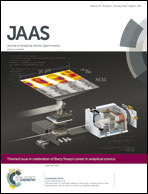In situ Nd isotope analyses in geological materials with signal enhancement and non-linear mass dependent fractionation reduction using laser ablation MC-ICP-MS†
Abstract
To improve the precision and accuracy of in situ Nd isotope analyses in geological samples, high analytical sensitivity and minimized non-linear mass dependent fractionation are desirable. In this study, we investigated the effects of three different cone combinations and the addition of N2 with the guard electrode, either grounded or floating, on the performance of Nd isotope analyses. Signal enhancements (2.5–3 folds) were observed for the Jet sample cone + X skimmer cone and for the standard sample cone + X skimmer cone, which were compared to those of the standard sample cone + H skimmer cone with the addition of N2 at 3 or 6 ml min−1. The influence of a guard electrode on the LA-MC-ICP-MS sensitivity was minimal for dry plasma conditions but became significant in the presence of N2. The addition of 3 or 6 ml min−1 N2 into the carrier gas increased the sensitivity for Nd by a factor of 1.6 with the GE-on mode for the Jet sample cone + X skimmer cone. However, in the GE-off mode, the addition of 2–3 ml min−1 N2 decreased the signal intensity of Nd by a factor of two to three. The makeup gas flow rate was found to have a significant effect on the mass bias stability of Nd isotopes, and this effect was different for different cone combinations. To stabilize the mass bias, measurements at elevated makeup gas flow rates was required for the combination of the X skimmer cone with the standard sample cone or Jet sample cone, at the expense of sensitivity. In notable contrast, the mass bias was stable for the combination of the standard sample cone and H skimmer cone under their corresponding optimum makeup gas flow rates. However, we found that the neodymium isotopes exhibited a large non-linear component at elevated makeup gas flow rates that could not be corrected by the accepted mass fractionation laws. The addition of 3–6 ml min−1 nitrogen to the central gas flow in laser ablation MC-ICP-MS was found to not only significantly enlarge the mass bias stability zone, but also to suppress the non-linear mass dependent fractionation for the combination of X skimmer cone with Jet sample cone or standard sample cone. The accuracy and precision of the developed analytical method for Nd isotope using Jet sample cone + X skimmer cone with the addition of nitrogen has been demonstrated by analyzing a series of reference glasses (JNdi-1 glass, LREE glass, NIST 610) and minerals (apatite, monazite and titanite). Results obtained for 143Nd/144Nd ratios in these reference materials are in excellent agreement with published values, demonstrating the capability of the developed analytical method to be an important tool for providing high-quality in situ Nd isotope data in geological samples.

- This article is part of the themed collection: Themed issue dedicated to Barry Sharp

 Please wait while we load your content...
Please wait while we load your content...